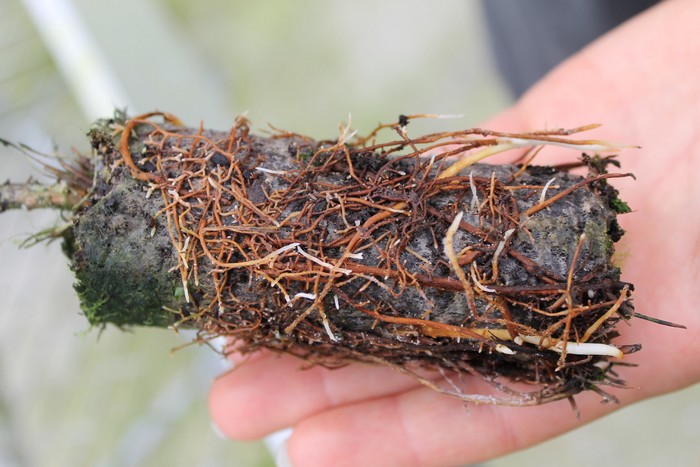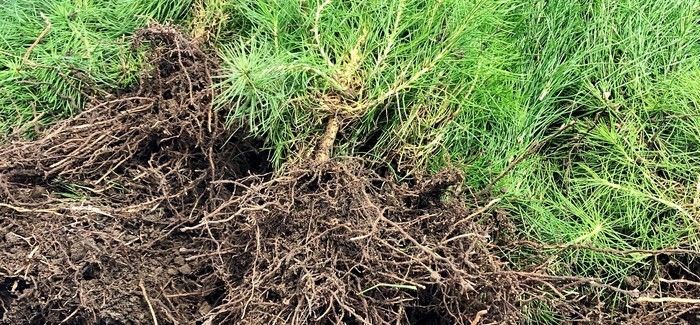Forest microbiomes: Small actors play a big part

The bacteria, fungi and other organisms that make up the soil microbiome affect the way trees and other plants respond to their environment, influencing forest health and function.
What is a microbiome?
A plant microbiome includes all the bacteria, fungi and other microbes that interact with a plant. The whole microbiome includes organisms in the soil around the roots, on the plant above ground and even inside a plant’s tissues.
The intimate relationship between plant and soil microbiome is generally mutually beneficial. Plants release carbon molecules that attract microbes by providing them with energy. In return, the microbes help the plant by improving uptake of nutrients and water, fixing nitrogen, producing chemicals that affect plant growth, or protecting against pathogens.
An important function of the plant microbiome is reducing plant stress. Pathogen damage, drought, salt, and organic and inorganic contaminants accelerate the production of plant stress hormones like ethylene. These can have negative effects on the growth of the plant. Some bacteria produce an enzyme that can break down the immediate precursor to ethylene. When these bacteria are present, they can help improve a plant’s resistance to environmental stress.
This interaction is one of many that indicate the potential to improve plant health and productivity and even to increase their resistance to environmental and other stresses through understanding and optimising microbiome/plant relationships.
A key research question Scion is exploring is how we can utilise the microbiome to protect plants from the impacts of climate change. Trees, as long-lived and sessile organisms, are highly exposed to impacts of climate change. If we can protect our trees and forests through managing the microbiome, we can future-proof all the benefits of forestry to New Zealand, from wood and fibre production, to carbon storage and supporting biodiversity.

Better microbiomes for seedlings
In seedling nurseries, fungicides are applied to control potential fungal diseases, and fertilisers are used to promote growth. Scion researchers have looked at the effect of fungicides and fertilisers on seedling microbiomes, tree health and how the seedlings later fare in the forest.
Initial research with pine seedlings found that the abundance of fungi that provided the greatest benefits to the tree was reduced with increased fungicide doses. Increasing exposure to fungicide was also associated with smaller seedlings (decreased root collar diameter).
Curious as to the long-term effects of manipulating seedling fungal communities, the researchers followed the survival and growth of nearly 2,600 seedlings that had been exposed to different fungicide treatments and then planted in the Kaingaroa Forest.
Trees that received low fungicide treatments had a significantly higher survival rate after six years and had a significantly greater plot basal area, compared to the standard treatment. Although the differences in fungal community structure associated with the trees disappeared after two years in the forest, the researchers concluded that the “better” fungal community on the seedlings that had received less fungicide in the nursery provided them with a head start that was still evident relative to the other fungicide treatments.
The effect of fertiliser application in seedling nurseries was also investigated. Seedlings that received standard or increased amounts of fertiliser were also larger at planting, however, after six years, no difference between fertiliser treatments could be seen.
The researchers caution that the stock for this field trial was obtained from a single cohort of seedlings from one nursery and the field results were derived from a single forest site. However, a range of other planting trials are now underway across New Zealand and interim results from those trials are aligning with those discussed here.
The work has provided an opportunity to explore the potential gains associated with precision use of chemical inputs and microbial community structure in the nursery. It may be possible to give seedlings a head start while also reducing the negative environmental effects from chemical use and strengthening the social licence of nurseries to operate.

Optimising the microbiome/plant relationship
The possibilities for understanding and exploiting the microbiome and its role in tree health in New Zealand’s plantation forests are intriguing but challenging. One factor is that the number of different microbial species involved can run into tens of thousands. In fact, soils are the most complex and species rich ecosystem known, with far greater diversity than tropical rainforests and coral reefs! Another aspect is the complex dynamic nature of the relationship and a multiplicity of factors such as plant genetics, soil pH, salinity, moisture and organic matter interacting with each other and changing with time.
For example, fertilisers are known to cause short- and long-term responses in soil microbial communities. Optimising fertilisation strategies, such as regulating doses, application timing, or choosing alternative chemical forms, have the potential to alter soil microbe community structure and function, creating direct effects on tree health and productivity.
Scion researchers have looked at what happened when fertiliser was added to plots of second rotation radiata pine planted in the Woodhill and Tarawera Forests. The two sites had differing soil physicochemical properties and, unsurprisingly, these were associated with site-specific differences in bacterial and fungal communities. Fertiliser addition affected the bacterial and fungal microbiomes differently at each site and the effects were long lasting.
Other work has looked at the effect of adding fertilisers containing different forms of nitrogen. Adding nitrogen in either organic or inorganic forms was found to affect tree growth as well as soil properties. These responses were also associated with variation in the microbial communities in and around tree roots.
The research team suggested that different nitrogen forms influence nitrogen and carbon dynamics where the plant meets the soil by causing responses in the roots that in turn cause changes in the root microbiome.
Future
Working with forest microbiomes is inherently challenging, but the potential rewards are substantial. This research is already creating new opportunities to increase forest productivity, optimise chemical inputs, improve soil properties and enhance the resilience of our forests to threats like climate change.
Scion researchers are actively developing plans to take this work further by attempting to capture the full depth and scale of the radiata pine microbiome, focussing on how it has allowed this species to survive and thrive despite the climatic changes and other major disruptions it has faced over the last 15 million years. This knowledge will uncover new pathways to work with the microbiome of this species, and also provide a blueprint for other tree species that are important to New Zealand.
